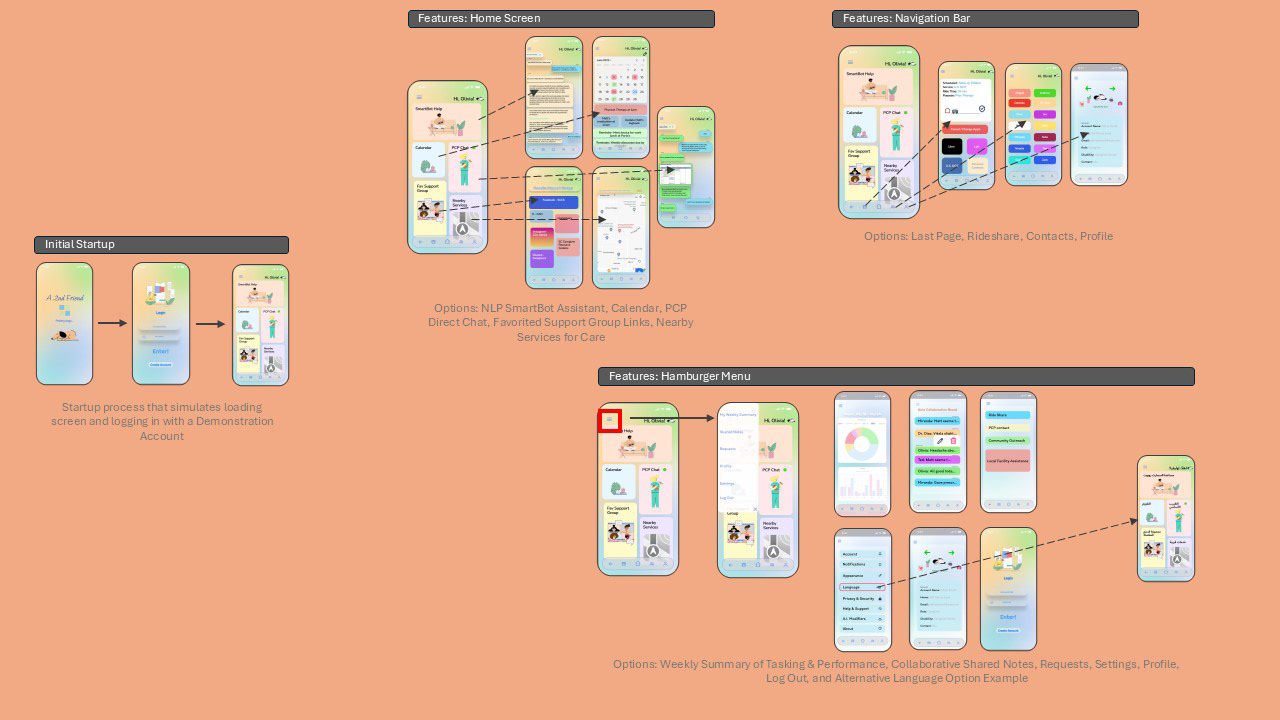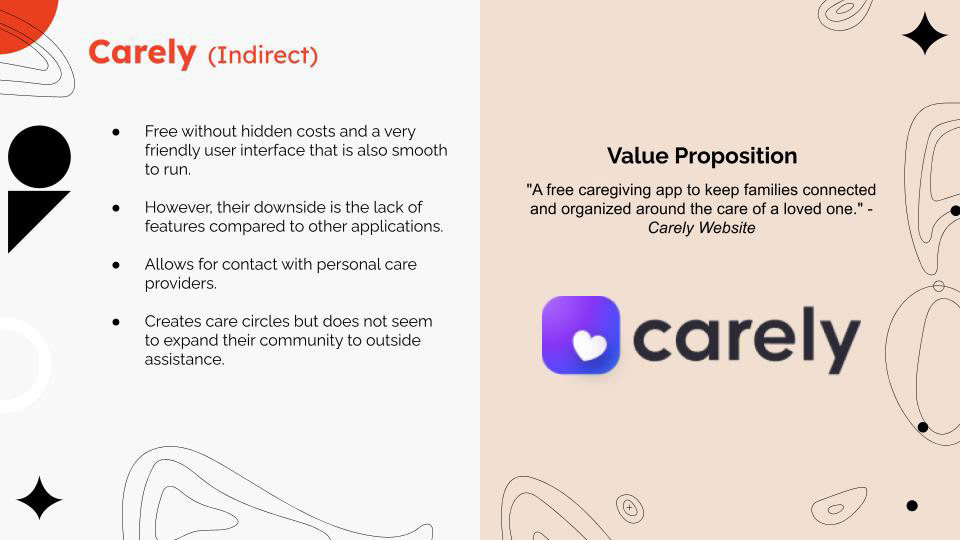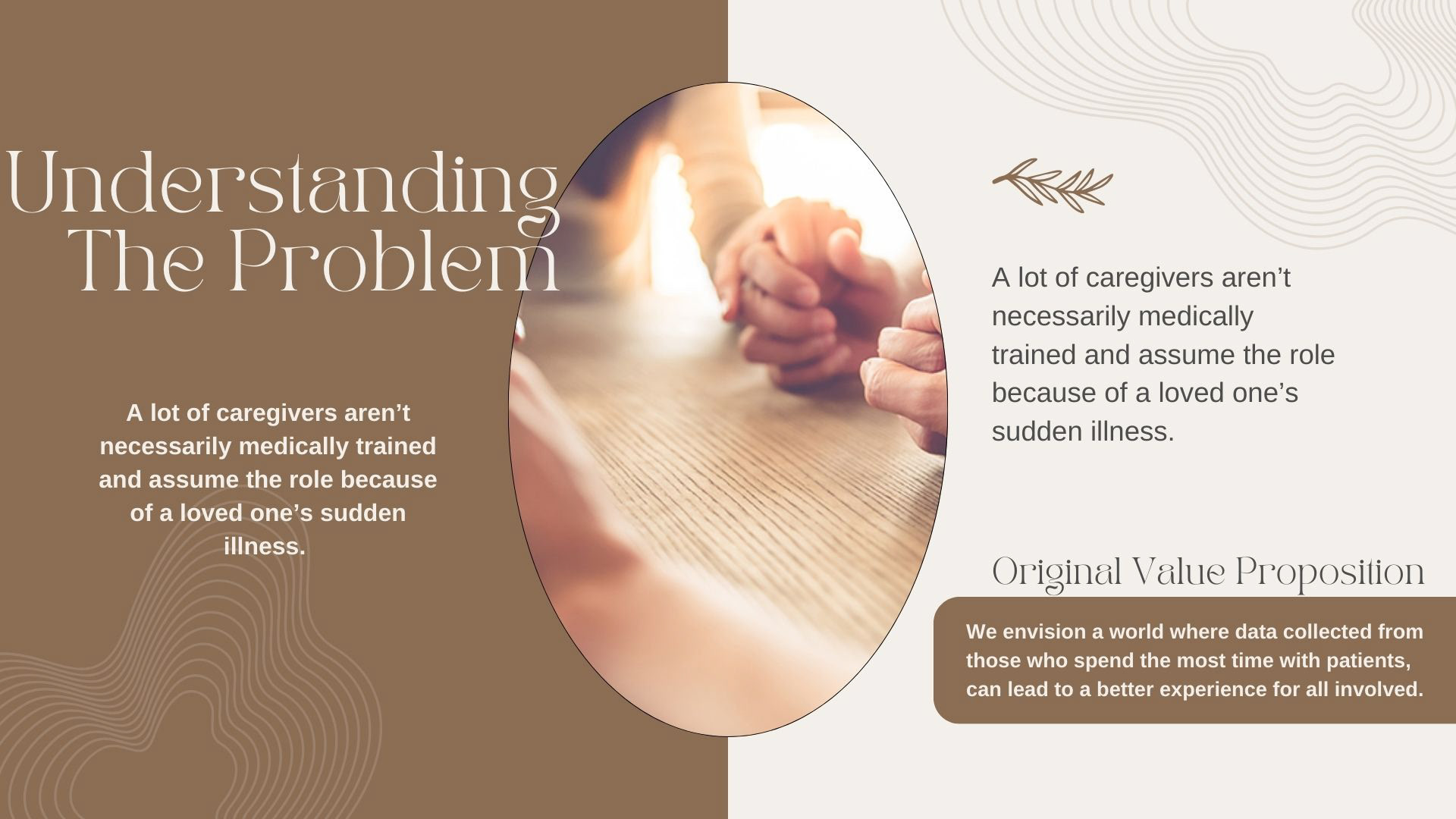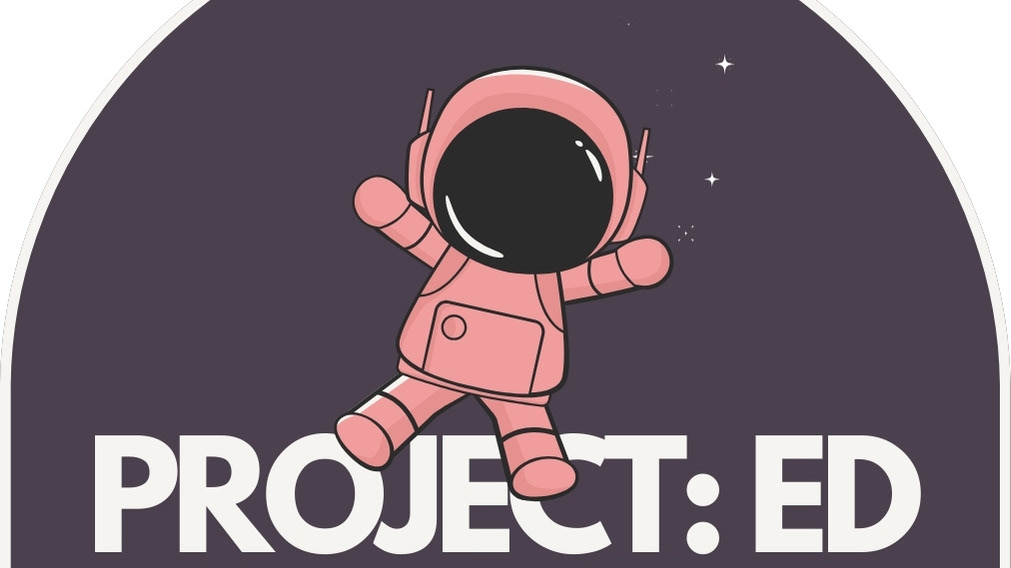2nd Friend (End-to-End)
Role:
Sole Researcher & Designer for the End-to-End Product
Overview:
2nd Friend was intended to live up to its namesake by being readily available for caregiver assistance.
Going into the project I knew beforehand that most caregivers were usually relatives who had no formal training in providing care. The original intent was to model an NLP assistant that could provide recommendations based on medical records and previously collected data.
After several interviews, I realized my initial goal was not what caregivers truly wanted and decided to turn my design to a more empathetic approach.
This was done for a class assignment with the professor acting as the acting stakeholder.
Background
Problem:
Newer caregivers face a unique situation with little prior knowledge and swift lifestyle changes. Many are not formally trained and only assume the role after a loved one’s sudden illness.
Value Proposition:
2nd Friend is the name I gave to a project tailored for caregivers of those with chronic disabilities to facilitate an easier transition into the role as well as provide quick, trustworthy advice in an unscripted role.
Goals:
Establish a robust application that meets amateur caregiver needs to perform their duties effectively. This was paired with a simulated NLP model that considers basic care practices and past treatments to tailor future recommendations.
This was accomplished by focusing on 3 overarching goals throughout the process: (1) Identify, (2) Incorporate and (3)Refine.
Research Plan Check-it-Out
A research plan was delivered to the acting stakeholder detailing goals, the research question, hypotheses, methods for data collection, methodology, participation standards, and proposed survey and interview items.
Research Question & Hypotheses:
Research Question: Can the livelihood of both the caregiver and patient be improved through the simplicity and assistance of a real-time, predictive-analysis treatment application?
Hypothesis 1: Participants will share common issues in qualitative interviews.
Hypothesis 2: With this app, caregivers believe their livelihood will significantly improve.
Hypothesis 3: Participants will see a significant benefit to using our application for community outreach as opposed to their prior solution.
Methodology:
Competitive Analysis:
A competitive analysis was done for the 6 most likely competitors to our application.
Evaluating Hypotheses:
Exploratory, qualitative interviews focused on understanding the participant’s lifestyle. Tests: Hypothesis 1
Prototype Testing & Improvements:
Qualtrics survey focused on having the participants interact with our prototype application. An unmoderated test. Tests: Hypotheses 2 & 3

Timeline
Competitive Analysis
Based on prevalence and reviews, a Google Sheet was compiled of the 6 largest competitors (direct and indirect) to the proposed 2nd Friend app. These 6 companies were studied to analyze distinct features that could give them an advantage and understand common trends in the market.
The latter half of the Google Sheet contains possible income from the competitors based on Sensor Tower information as well as a UX/UI heuristic evaluation of each product.
Companies (6 total):
- Dementia Talk, Carely, Constant Therapy, Caring Village, Symple, and Lotsa Helping Hands
Assessed Characteristics (13 total):
- Region, Direct/Indirect Competition, Price, In-product Services Provided, Login Method, Year Founded for Age, Last Update of App, Average User Reviews, Category in App Store, Appx. Downloads, Revenue Stream, UX/UI Heuristic Evaluation, and any additional unique information.
Notable Industry Concerns:
- No other app provided alternative language options.
- Many apps were either no longer available or consistently supported. (Dementia Talk, Carely, Caring Village).
- The sole paid app (Constant Therapy) appeared to be the only helpful and practical product.
- Constant Therapy was the #1 direct competitor to the proposed 2nd Friend product.

Qualitative Interview
Process:
Qualitative interviews were conducted with caregivers from around the U.S. Midwestern region, each taking care of a family member of various disabilities. All participants (n = 3) were females in their 40s.
The disabilities included:
(1) An Alzheimer’s diagnosis for compensation but possible CTE
(2) Physical and some neurological debilitation after a prolonged stroke
(3) Senior citizen recovering from chemotherapy for recurrent cancer.
Notable Quotes Pulled to Help Develop the Main Themes:
“His PCP diagnosed my husband with Alzheimer’s in order for us to receive benefits and coverage from our insurance. Believed to have CTE, but can't be diagnosed until postmortem.”
“Taking care of my mother equates to about 42 hours per week, but we can split the time with my two sisters.”
“he never took [political] sides. He was also never religious at all and now believes that I am possessed by a demon…[Name] and I have been married for 30 years…Here's this person that I've spent the majority of my life with, and he has become completely the opposite of who he used to be. It's the emotional, personal attack kind of things that are hard.”
“I guess it has not affected my career. If anything, my career kind of helped me as being a caregiver because…I work for an ENT office.”
“Suggested to look for Alzheimer family support groups for their kids but again, kids of Alzheimer's groups tend to be my age [40s], that's not gonna help a 15, 16 year old… I used to be a part of a group on Facebook that was for early onset Alzheimer's caregivers… It was fantastic… I don't have it anymore, and I have not found another group like that somewhere else.”
“He was a vice president of an internet division of a marketing company for 20 years…nine concussions that over his lifetime…but he definitely can't work.”
“My husband was an accomplished practitioner who had a stroke and was too far from help in time.”
After waiting 6 months for an answer “The state recommended I just divorce him and surrender him to the state.”
Qualitative Interview Affinity Matrix Check-it-Out
Updating the Persona
Based on secondary research, a proto persona was developed detailing prior believed goals, frustrations, demographic information, and skills of the typical caregiver.
Changes:
After analysis of the qualitative interviews, several key pieces of information were updated to more accurately reflect caregiver livelihoods and needs. These include:
Added:
(1) An additional goal of finding a reliable support group to connect with those who can understand and empathetically share in support.
(2) A frustration of financial strain and earning barriers that can prevent necessary support from social programs.
(3) A frustration of emotional hardships when dealing with loved ones who have changed on a personal level due to their illness.
Removed:
(4) A goal that stated they wanted more free time since it did not appear to be a major concern.
(5) A frustration that the added caregiver role is preventing them from continuing their career. Work-life was impacted but it was not a major frustration.
Prototype Development
The prototype was created in Figma and attempted to meet all wants that were proposed from the qualitative exploratory interviews as well as features that were noticeably missing from competitors.
The GIF to the far right is a preview of the finished prototype which can be viewed Here or by clicking on the image.
Notable Features of Prototype:
Predictive Analysis [SmartBot]: This feature would be where our predictive analysis output would display. It would be designed to assist in care.
This advice would be based on personalized collected data and medical records to provide tailored consultation.
PCP Chat: Real-time communication with the primary care physician’s office
Maps: Allows users to search for nearby facilities
Rideshare: Allows users to request transportation for their caregivers in the app and track the progress of the trip.
Language: Offered support for additional languages, a feature absent in competitors' offerings.
Shared Notes: More of a forum-style collaboration between users for the same caregiver to share notes and communicate.
My Weekly Summary: A report that can be generated to display trends, medicine history, appointment history, caregiver duties, etc.
Calendar: Distinguish urgencies between tasks as seen by red (cannot miss), blue (important daily tasks), or green (casual events).


Insights
After the prototype was developed, unmoderated usability testing (which included both the qualitative interview participants as well as others) was conducted in tandem with a mixed-methods survey.
Survey Results
Design:
A Qualtrics survey was conducted with an unmoderated usability test of the 2nd Friend prototype.
The participant sample size (n = 4) was collected through convenience sampling. Not ideal but enough to gather immediate insights.
Questions:
20 Likert 7-Point scale questions with 1= very disagree while 7= very agree.
1 rank order question with all features
1 voluntary open-ended response for feedback and comments.
Question Category:
Questions1-5: Personal Experience
Questions 6-12: Feature Evaluation
Questions13-20: Overall UI
Key Takeaways:
-The open-ended response appeared to be a positive choice since it generated the best immediate feedback.
-Users seemed to enjoy the overall UI experience as opposed to the features.
- Personal experience was only slightly above neutral towards negative feelings of external issues.
- 21% average increase above neutral for Overall App UI.
Highest Mean Responses:
Question 01: Feeling overwhelmed.
Question 19: I would put this app on my phone’s home screen.
Question 20: App information was clear with little medical jargon.
Question 01: Feeling overwhelmed.
Question 19: I would put this app on my phone’s home screen.
Question 20: App information was clear with little medical jargon.
Interview Results
Design:
The participant sample size (n = 3) was collected through convenience sampling.
Key Takeaways:
The NLP's importance seemed comparatively minor to participants' other needs. So other features were incorporated and prioritized to include:
(1) Community outreach since a lack of social support was a priority
(2) Direct communication with the care recipient's PCP team
(3) Integrated ride share and calendar options to minimize management responsibilities.
Validating Assumptions About Caregiver Priorities:
General priorities were verified by assumptions based on secondary research and others were not supported.
Noticeable Priorities:
Support Groups, Medication Discipline, PCP & Specialist Communication, Overworked Emotionally, Physically & in Morale, Having Family Understand & Help
Not a Priority:
Boost Career Opportunities, Access to PCP, and Treatment Concerns
Presenting the Findings
Competitive Analysis Slide Deck Check-it-Out
A slide deck was created from these 6 competitors and includes recommendations based on the overall competitive analysis highlighting key information such as:
(1) Constant Therapy is the #1 direct competitor
(2) Summarized market findings
(3) Where to direct regional focus.
A 10-minute presentation was delivered to the acting stakeholder highlighting key insights from the end-to-end process.
The information in the presentation mirrors this case study but is tailored for a more digestible format. This allows for a presentation to those with a novice understanding of UX.




Lessons Learned & Recommendations
Lessons Learned:
Adaptability:
I came into the project with strong assumptions of what caregivers desired, despite not interacting with someone in that position on a personal level. I learned to set my passion and pride aside for a "fancy NLP model" in order to address their actual needs.
Nescience:
I came into this project greatly underestimating all the roles and facets a caregiver could need. I had a prior understanding of their lifestyle but this project highlighted the importance of thorough research and participant interaction.
Realistic Expectations:
A project that attempts to address all concerns could end up addressing none. Some ideas may look great in theory but on the practical side, the prototype felt incomplete for each area. This was due to the time and effort necessary to flush out each feature that I was not able to commit due to a lack of resources, time, or expertise.
Recommendations:
Immediate Changes:
Fix UI Issues: Remove the 'calming; animal introduction that only brought confusion to the app's purpose.
Correct Survey: Greatly reduce the number of questions and tasks assigned to the demonstration.
Features: Minimize the goal to be a one-stop shop. Focusing efforts on everything led the prototype to be great at nothing.
Long-Term Changes:
Fix UI Issues: Seek further feedback on the lack of intuitiveness such as the 'calming' animal on the startup screen.
Correct Survey: Tweak questions to eliminate confusion.
Features: Improve on features executed relatively well such as direct communication with PCP chat.



